Providing first aid with social distance
How do you provide corona-safe first aid? By observing the one-and-a-half-meter rule as best as possible, putting on protective blue gloves and wearing a face mask, policy makers say. But can you help victims this way in practice? Cursor spoke to those responsible for safety at TU/e, and took part in the Emergency Response Course new style.
Working from home is still the norm for employees and students. Therefore, the approximately one hundred and fifty TU/e employees on the in-house emergency service team are present on the campus less often as well. Should we be worried that no one will come and help when someone has an accident, or when a fire breaks out in a lab?
“For buildings with no or too few in-house emergency response workers present, it’s possible since early 2020 to call upon an Emergency Response back-up team,” says Eric van der Heijden, commander at the TU/e fire department. The back-up team is called Rapid Response Team (RRT) and consists of personnel from the university’s fire department. TU/e is running a pilot with the team, which was set in motion before corona entered our country. Simone Vonken, policy officer at the Facility Management Center, is its project leader. “We want to evaluate our experiences with this pilot in December. How is it working out? Is there an actual need for an RRT?”
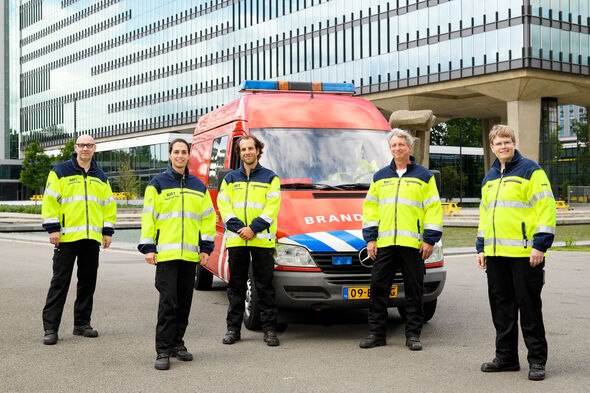
On and a half meter
In the meantime, however, we have to deal with corona. TU/e’s policies are in line with the Emergency Response guidelines of the Netherlands Institute for Emergency Response (NIBHV). “What’s important here is to keep a one-and-half meter distance whenever possible,” Eric van der Heijden says.
Providing first aid without touching victims? Let’s try that during an exercise. I myself am an in-house emergency response worker in the Auditorium, and on Tuesday morning I attend yet another refresher course. Today is the first time Toos van Doorn, who has been giving Emergency Response courses at TU/e for the past eighteen years, teaches a group that has to maintain a distance. Of the eleven TU/e employees assigned to that group, four are present in Fenix.
“The strictest NIBHV measures already no longer apply,” Van Doorn says. “At first, you were only allowed to check whether an unconscious person was breathing, now you’re allowed to feel the person’s back or chest again, and to listen at the mouth with your ear. Whether or not to give mouth-to-mouth resuscitation is for everyone to decide individually. But the main rule during Emergency Response is still: ‘do not put yourself in danger.’
“What happened?’
To experience what it’s like to make a diagnosis from a distance, the four of us have to practice on the acting performance of Karin, Van Doorn’s assistant. She comes staggering into the room with her leg dragging behind her. She tells us that she twisted her knee while practicing sports. Does she have a torn ligament in her knee? There’s no way to tell. But what should we do? One of the participants in the course thinks Karin should lie down quietly and wants to call 2222 (the emergency phone number on the campus, ed.). A second participant thinks Karin should put ice on her knee and have someone bring her to the general practitioner, and participant number three wants to call a taxi that will drive Karin to the emergence care. “That’s something we’re not allowed to do,” Van Doorn says. “When we estimate that someone is in need of emergency care, we call 2222. TU/e security then immediately calls 112.”
Confused
Karin acts as if she had been in an accident, or suffered a heart attack perhaps, no fewer than six times. She enters the classroom with an open wound to a finger, a burn wound in her face or an imagined broken collarbone. When she enters pale as death and sweaty, we have no idea what’s wrong with her. Sandra Peters, project manager Smart Cities at TU/e innovation Space, finds it hard not to get up. “Normally speaking, I would support you now, and carefully get you to sit down on the floor,” she says helplessly. The fact that Karin tells us that she’s seeing light flashes and feels very bad, should suggest to us that she’s experiencing the early stages of a TIA, a temporary brain infarction. “Making a diagnosis of someone you don’t know is extremely difficult,” Van Doorn knows. “Therefore, once again: call 2222. You’ll get contact with 112 and they will ask you professional triage questions. Imagine that the victim starts to feel better, in that case, the ambulance can turn around and you can organize your own transportation to a general practitioner.”
Going outside
During two of today’s three exercises, keeping distance isn’t hard. We extinguish a fire in a trash bin and give each other instructions via the walkie talkie. But when using the Evac Chair, with which you can evacuate a disabled person via a stair case, two people have to lift a heavy doll into a kind of wheel chair. Fortunately, there are enough face masks available today.
During my first on campus work day, I mustn’t forget to put an approved medical face mask into my Emergency Response bag.
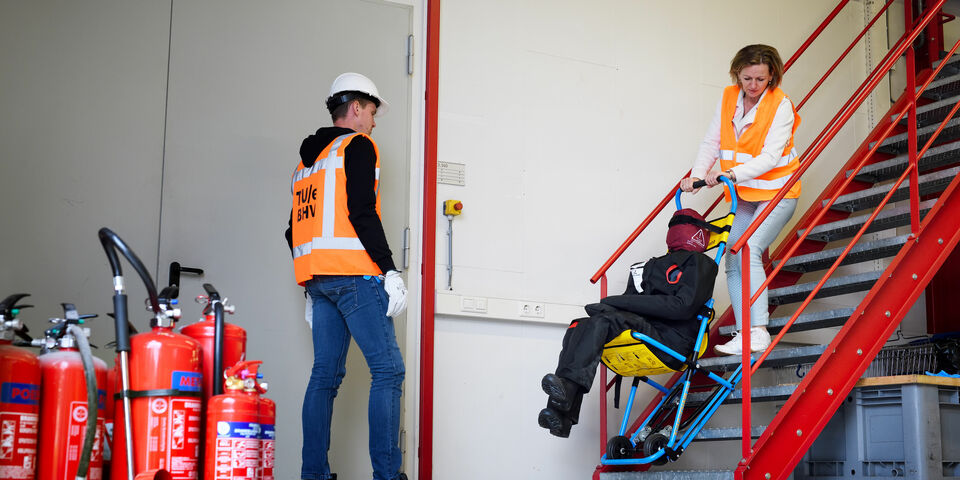

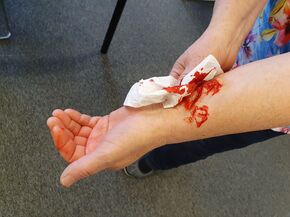
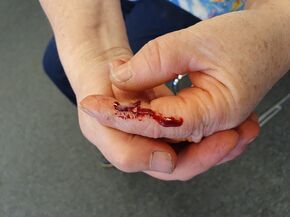
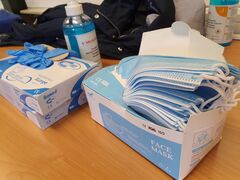
Discussion